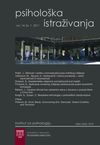Ergonomski faktori rizika i fizička nelagodnost korisnika laptop računara
Ergonomic Risk Factors and Physical Discomfort in Laptop-Computer Users
Author(s): Vladimir Stanković, Svetlana ČizmićSubject(s): Psychology, Health and medicine and law, ICT Information and Communications Technologies
Published by: Филозофски факултет, Универзитет у Београду
Keywords: ergonomics; human-computer interaction; laptop; discomfort; RULA technique;
Summary/Abstract: The aim of the study was to determine the risk factors for discomfort in laptop users. Subjective feeling, load level, intensity and frequency of discomfort were examined. The study included 186 subjects. In the first phase participants completed a questionnaire about the subjective feeling of discomfort and specifics of laptop usage, while in the second phase 10 participants were observed while working on a laptop. Upper body postures were assessed with the Rapid Upper Limb Assessment (RULA) technique. Nearly one fifth of respondents showed a higher incidence of discomfort. Majority of subjects reported wrong sitting posture and unusual body postures as main factors that increase discomfort after laptop usage. After using a laptop, discomfort increases primarily in the neck, with risk factors being working for several hours continuously, in the environments with no fixed area for device placement and without using the external devices. In most positions neck extension/ flexion was noticed as a result of the specific device design. Discomfort is increased in the back, although somewhat less than in the neck. Risk factors are amplified while working continuously for several hours, working for more than five hours and in postures like sitting on the bench and without external devices. Discomfort also increases in hand wrist, in users who mostly sit on fixed surfaces. The RULA observation has shown that the risk is the greatest in the following positions: when laptop is used while sitting on the floor, lying down, and with the device on the lap. The findings have important implications for improving laptop users’ wellbeing in contemporary work environment.
Journal: Psihološka istraživanja
- Issue Year: 17/2014
- Issue No: 1
- Page Range: 19-33
- Page Count: 15
- Language: Serbian

